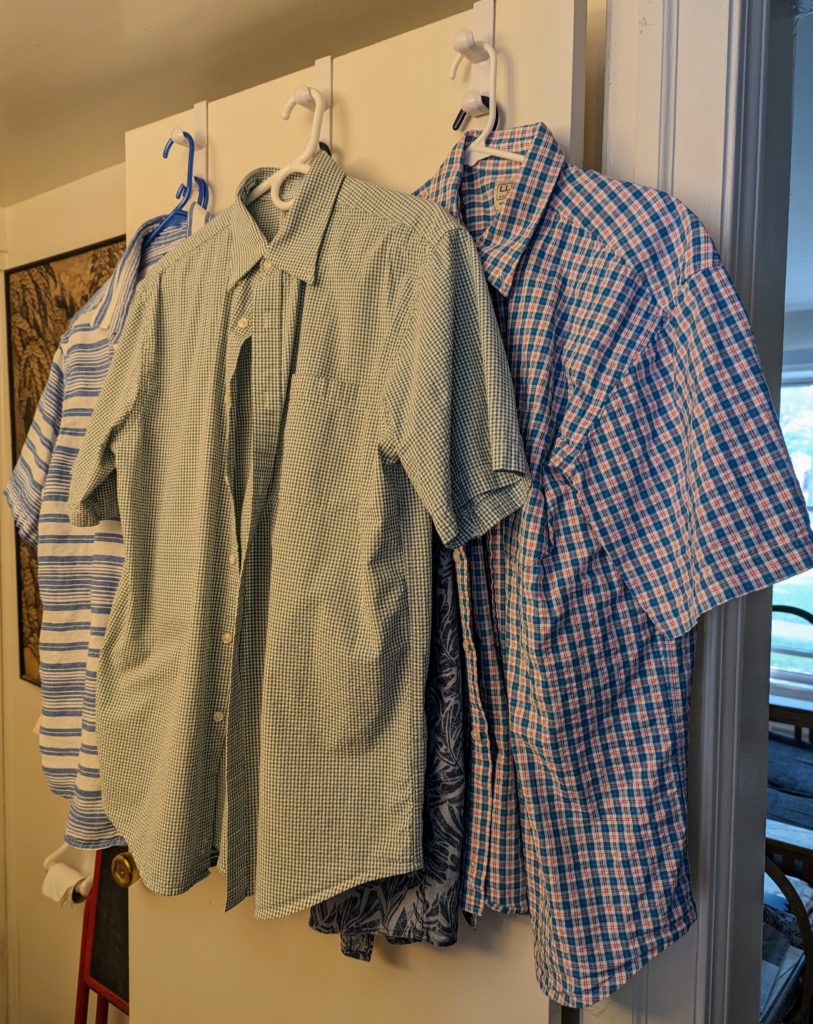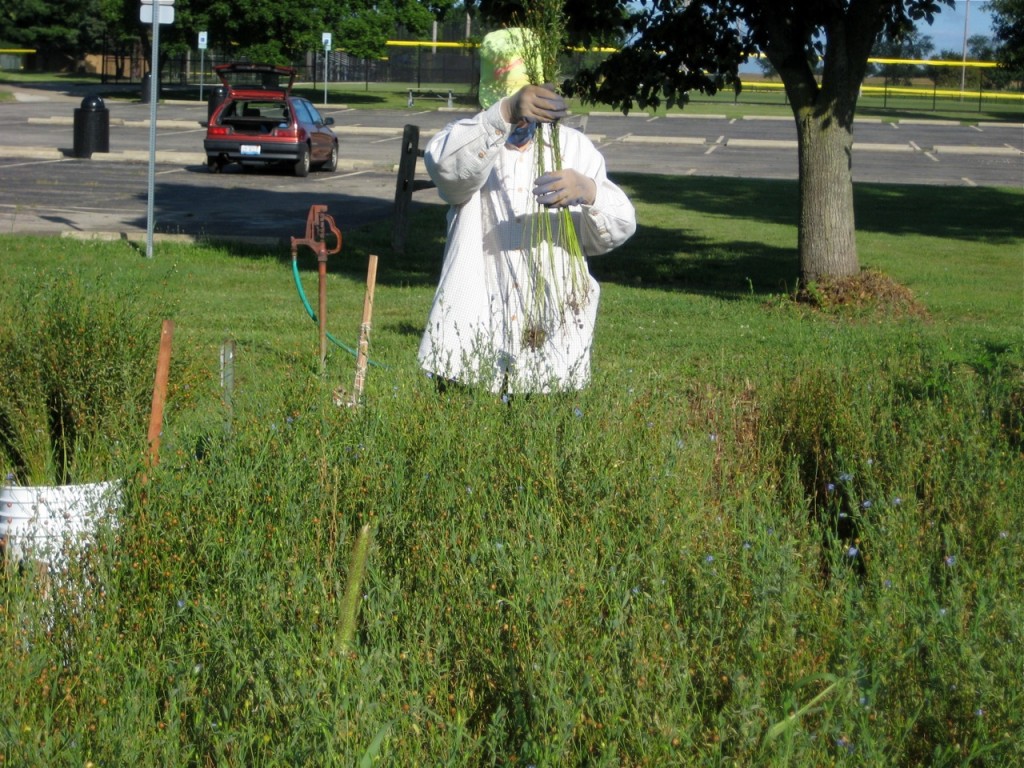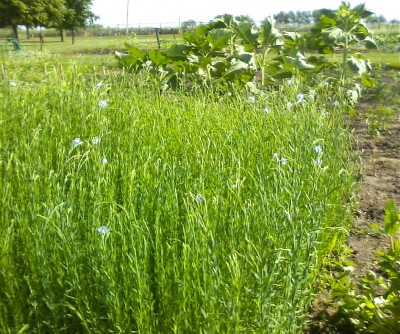I ironed a bunch of shirts to pack for my upcoming trip to St. Croix. #STX
Looking forward to sipping morning coffee and evening rum punch on the porch and under the tamarind tree, wearing a series of linen, seersucker, and madras plaid shirts.


I ironed a bunch of shirts to pack for my upcoming trip to St. Croix. #STX
Looking forward to sipping morning coffee and evening rum punch on the porch and under the tamarind tree, wearing a series of linen, seersucker, and madras plaid shirts.


I’ve fallen rather far behind on my posts about growing flax this year, so this is something of a catch-up post. It covers the work we’ve done since harvesting—and not only brings us up to date, but pretty much finishes up the series. Jackie will, of course, spin our flax fiber into yarn, but she spins all the time, so that’s just normal around here.
So, in quick succession, here are the next steps after harvesting:
It’s a little odd that you’re supposed to dry the flax, giving that the next step is to soak it in water, and yet that’s how it’s done, and who are we to go against tradition?
Here’s one of our little flax stacks. This is well along in drying, although you can see that some of the interior stems are still pretty green.
Once the plants are dry, you want to remove the seeds. There’s a tool that’s basically a bed of nails spaced appropriately for catching the seed pods.
I neglected to get a good picture of our ripple, but here’s one cropped out of a larger picture:
You just draw each bundle of plants through the ripple a few times, and collect the seed pods that pop off.
We got a big coffee container full of seed pods. Unfortunately, a lot of the seed pods only have two or three seeds in them, making it pretty tiresome work to get flax seeds. If you spend about fifteen minutes at it, crushing each pod and then getting the seeds out, you can get maybe a quarter-teaspoon of seeds.
I blame colony collapse disorder. (Flax is bee-pollinated. The native bees do the best they can, but evidently without complete success.)
Once the flax is dry, you rett it—you subject it to a controlled rotting process, the purpose of which is to do some damage to the stem so that you can get to the fibers.
We retted our flax in a kiddy pool that we bought cheap at a local discount store:
You need to weight the flax down so that it’s all under water. We used some vinyl shutters that we got cheap at the Habitat for Humanity ReStore, together with some cheap tiles as weights.
Here’s a closeup of the bundles under the weights:
Retting is generally considered a stinky process, although ours wasn’t too bad. We retted each harvest separately, and it took about five days each time.
After retting, you have to dry the flax bundles. I didn’t get any pictures of this phase, but it’s not really different from the first phase of drying, except that now the bundles are rather limp, so that you need something for them to lean against if they’re going to stand up. The bundles have gotten lighter, though, so it doesn’t need to be anything very sturdy. We used the flower stalks of our bolted lettuce as supports.
Once the stems are dry, you need to break up the stem material that surrounds the fibers. This can be done with your bare hands (I did a couple of stems by hand, just to see the process in detail), but it would be pretty time-consuming and tedious. There’s a special tool for automating the process called a flax break. It’s kind of like a big paper-cutter, only with multiple blunt wooden blades
It turns out, there actually is a flax break not too far away, owned by Five Mile House, a historic homestead just south of Charleston, Illinois. They offered to let us use their flax break if we’d demonstrate how it was used.
So, on one Sunday in September, Jackie and I went to Charleston and “demonstrated” how to break flax. (I put the word in quotes because we really had no idea how to use the flax break, so our demonstration consisted mostly of letting people watch as we tried to figure it out.)
We only got about half the flax broken during that three-hour period, so we went back yesterday and finished the job.
If you do a good job of breaking, most of the unwanted material falls right off. (That material is called “boon” and is supposed to be good for all sorts of things. Basically, it’s mulch.)
Inevitably, some bits will still be wrapped around your fibers. Those bits are removed through scutching, which is striking the fiber bundles with something sharp enough to scrap things off the fibers, but not sharp enough to cut them. A real scutching knife looks rather like a wooden sword. We didn’t have one, but made do with various other items, such as a spatulas.
The last step is to comb the fibers to make them ready to spin. This step is called hackling, and is done with a hackle, which is basically a bed of nails like a multi-row ripple.
You just grab the scutched bundle in the middle and draw it through the hackle. Any short or tangled fibers will get caught in the hackle, and after a few passes, the bundle in hand will be a tidy bundle of long, straight, neatly aligned fibers. The long fibers are called “line” flax, and are considered the good stuff. The short fibers are called “tow” and are perfectly good fibers, useful for many things, but not fine linens.
In our second visit to Five Mile House we finished breaking our flax. We also got a good bit scutched and hackled. What had been enough flax bundles to completely fill the back of our hatchback is now just three paper grocery bags full of fiber.
That’ll be enough to keep Jackie spinning through the winter.
It’s been a very interesting process, and a lot of fun, but I doubt if we’ll do it again.
My plan for next year, as crop to occupy a big chunk of the garden so we don’t have to keep weeding it, is barley. (First year, malt syrup. If that works, second year, maybe beer.)

It’s hard to decide when to harvest flax. If you harvest early enough to get the finest fiber, you get no seeds. If you harvest late enough to get seeds to plant next year, you get coarse fibers.
The books suggest various compromises. One suggested 30 days after the peak of flowering, if you mostly care about fiber, and two weeks later if you mostly care about seeds.
We decided to harvest half of our plants today. We think it’s early enough to get good fiber. Indeed, some of the plants are still in flower. But there are plenty of seed pods that look like they’ll be full of seeds.
Depending on how things go, we’ll harvest the other half in a week or two. That may get us some more or better seeds. At least as important to me, it adds a bit of redundancy—if something goes wrong with the processing of this batch, we’ll have another batch that won’t suffer the same fate.
Jackie has suggested that we not try to save seeds to plant, but rather eat the seeds we get. (I assume she means to grind them up to use as flax-seed meal, which we do buy at the store and put in bread and such. Even if every seed pod turns out to be full to bursting with seeds, we’re only going to get a few tablespoons of flax-seed meal, but that’d be enough for several loaves.)
The first step to turn flax into linen, after growing the plants and harvesting them, is to dry them. The books suggest that you tie the stalks into bundles, then arrange the bundles into loose stacks for drying.
That’s where we are now:

 Jackie and I visited our garden today, where we’re growing flax with an eye toward making linen. We were pleased to find the first flowers on our flax plants.
Jackie and I visited our garden today, where we’re growing flax with an eye toward making linen. We were pleased to find the first flowers on our flax plants.
Sorry for the crappy photo—I neglected to bring my camera, so this was taken with my phone. Worse, it was windy, so everything was moving. Still, it gives you a general idea of how our flax is coming along—close to knee-high, and very thick and lush. (Apparently growing very thick is preferred if you’re growing flax for fiber, rather than for seed. Thickly packed plants grow straight and tall without branching, so you get the longest fibers. More sparsely grown plants tend to branch out, which is fine if you’re growing the plants for flax seeds, but not ideal if you want textile fiber.)
Somewhat more successfully, I took this photo of some bison with calves, in a field behind the hotel where we stayed in Greenville for our Sharp family reunion.
It was on my first trip to England that I came to understand that what we think of as formal wear, business attire, and sports clothing was originally designed to be the most comfortable possible clothing for the circumstances. The circumstances in this case being the climate, technology, and infrastructure of England in the eighteenth and nineteenth century.
Without central heat interiors were going to be chilly, but even if you were quite frugal with your wood or coal they would not have to be really cold.
Given those indoor circumstances, and given that you had to make do with wool, silk, linen, and cotton (because there were no synthetic fibers), you would quite naturally end up with just the sort of garments that we now think of as being part of formal wear—wool coats and vests, silk bands to wrap around your neck, and so on. Sport clothing, of course, was for the sort of sports the English aristocracy engaged in: riding and shooting. Tweed and leather were very practical.
It seems obvious now, but it was something of a revelation to me. When I was younger, I always thought of that sort of clothing as being uncomfortable.
Partially that’s because such clothing is only really comfortable if it really fits. You don’t need a bespoke suit for it to fit correctly; even today good men’s clothing is routinely altered to fit. But clothing purchased for a child will never fit for long (and often never fit at all, because the child knows neither how the garment is supposed to fit nor how to articulate any issues discovered during the fitting).
Perhaps more important, such clothing is only comfortable in the sort of very cool environment for which it was originally designed. If your interior temperatures are around 60°F, you will be more comfortable in a wool coat over a wool vest than you would be in shirtsleeves. At 70°F it will be the other way around.
My attitudes toward such things has also been influenced by Jackie’s work with fiber. In my youth, my experience with wool was that it was scratchy, uncomfortable stuff (totally aside from it being made into garments that didn’t fit and were wrong for the climate). Now I’ve learned about the many different kinds of wool—starting with merino, of course, but by no means ending there—that are not scratchy. Now I have wonderful vests and sweaters, made to fit, from premium materials.
Of course, the top layers are really the last thing to think about. Comfortable clothing begins with the base layer. There again, my experiences as a child turned me against a whole very useful category: long underwear. Any clothing that you’re going to put another layer of clothing on top of needs to fit exactly right. An outer layer that’s too loose can be tolerated. But a too-loose under layer is going to get bunched up and shifted away from where it needs to be: Intolerable.
The ill-fitting hand-me-down long underwear I got as a child turned me against a whole category of garments that doubtless have an important role to play in comfortable dressing. I’m only now, more than two decades after returning to the Midwest, beginning to accumulate items for an appropriate cold-weather base layer. (I’ve made do up to now by having a wide range of top-layer options: spring jackets, fall jackets, winter coats, parkas, my Alaska pipeline coat.)
As a young man, I think I’d have been perfectly happy to wear nothing but shorts and t-shirts, and simply crank up the heat to make up the difference. My attitude has changed. If I had the money, I’d be very pleased to get and wear wool coats and vests, silk cravats, smoking jackets, and the like. Not because of the fashion statement they’d make (which would be a rather silly statement, however much I’ve come to appreciate a fine tweed), but because they’d be very comfortable.
It happened this way:
We were going to brunch with Barbara at Windsor, where they prefer that people not wear jeans in the dining room, so I wore khakis. Then, since I was wearing those, I decided to wear my khaki linen shirt. I don’t wear it much, for various reasons. (It’s long sleeved, so I don’t tend to wear it when it’s hot, but it’s linen, so I don’t tend to wear it when it’s cold. Plus, since it’s linen, it needs to be ironed. Plus it’s been ever-so-slightly on the snug side, but I’ve lost a little weight, so it’s now fitting quite well.)
That outfit was going to have me looking just a bit dressed up, so I though maybe I’ll go whole-hog and wear my tweed jacket. That, plus the fact that the linen shirt has a button-down collar, made me think that maybe I wanted to wear a tie. And then, since it was the day after Christmas, it occurred to me that I could wear my Christmas tie—a very red, very shiny tie that my mom made about 30 years ago. It’s so red and so shiny that there’s not really much other opportunity to wear it.
To go out, I wore the trench coat my dad gave me last summer. It used to be just a bit on the snug side as well, but fits just fine now (even over my tweed jacket). But it’s not quite as warm as a parka, so I added the grey scarf Jackie wove for me last year. It’s the newest of my many handwoven scarves, and perfect for when one of my more colorful scarves would be insufficiently understated.
I looked at myself in the mirror and thought, “Wow. I look just like a grownup.”
Then I put on my grandfather’s homburg and headed out to brunch.